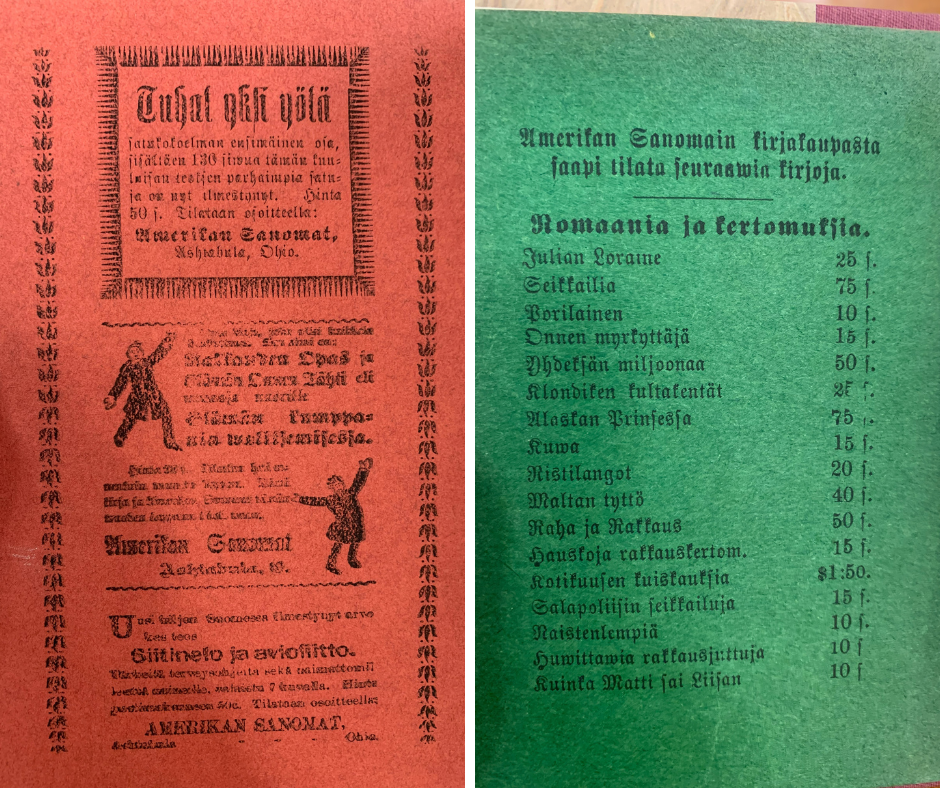AUTHOR: Lotta Leiwo
Research material corpus: Ashtabula
As we started our project in February 2022, PI Kirsti Salmi-Niklander and myself started to map T-Bone Slim’s early life and childhood in Ashtabula, Ohio in late 1800s. How to understand what life was back then? What kind of services they had and how they kept in contact with other Finns in North America? What kind of material is available from Ashtabula Finns?
Soon we discovered a large material corpus from National Library of Finland that consist altogether 86 publications from 1878 to 1941 published in Ashtabula. These include three newspapers, one periodical, history books, dictionaries and phrase books, poems, guidebooks (how to tend farm animals, how to kiss, how to get a husband and so on) small stories and poems written by self-taught writers, translated literature and spiritual texts. And these are just the publications stored in the archive. Most of the small publications include a list of booklets for sale in Amerikan Sanomat publishing company indicating very lively publishing production in Ashtabula. Only part of these are preserved.

Amerikan Sanomat publishing company
Most of the publications are published by Amerikan Sanomat publishing company. Amerikan Sanomat published variety of small publications and of course a newspaper called Amerikan Sanomat (The American Newspaper, published 1896–1913). The main character working in Amerikan Sanomat was August Edwards who besides having a lively publishing company, delt a variety of peculiar goods such as electric belts (yes, it seems they are the same kind we see in shopping channels still today), cipher alphabets to write secret letters between lovers, mechanical music instruments (roll organs) and special pocket watches that worked as a kind of calculator.
Pohjantähti and Aleksi Wirtamo
Another even more interesting character to us is Aleksi (Sergei Feodorovitz) Wirtamo who published Pohjantähti newspaper (The North Star) earlier in the 1880s. Pohjantähti was a short-lived paper Ino Ekman and Wirtamo started together in late 1886 and it appeared only for one or two years. Paper was eight pages (as later Amerikan Sanomat and many other relatively small newspapers in U.S.) and appeared once a week on Mondays. Aleksi Wirtamo is particularly interesting to us because he was married to T-Bone Slims aunt, Edla Wirtamo (maiden name Huhtaketo). Edla is T-Bone’s mothers Priitta Johanna Huhtaketo’s sister.

Before Pohjantähti, Wirtamo worked as a journalist in another Finnish American newspapers Yhdysvaltain Sanomat (Tidnings of the United States, published 1885–1893) and Uusi Kotimaa (The New Homeland, “the oldest Finnish newspaper in the US” published 1881–1934). After Pohjantähti, that Wirtamo left during 1887, he worked at least as a goods distributor: he advertises cigars in Amerikan Sanomat at least in December 1899. The cigars were called “Suomi suree” (Finland mourns) cigars referring to first period of oppression: the period 1899-1905, when the Russian Empire sought to consolidate and unify the Russian Empire by implementing a policy of Russification of minority nationalities against the Grand Duchy of Finland. By smoking “Suomi suree” cigars Finns in North America could express solidarity to their fellow citizens back in Finland. In the same ad, Wirtamo advertises “headache powder”. At that time, Wirtamo lived in Conneaut Harbor, Ohio, close to Ohio-Pennsylvania border approximately halfway from Ashtabula to Erie.
Why these materials?
By reading material published in Ashtabula in the turn of the century we can understand the everyday life of Finns in Ashtabula from several news and even from the advertisements. At the time, social status and dynamic relationship between parents and children were in change at the time. Children became subjects of raising and actors in family and in society. This shift can be seen by reading the material: almost invisible children in 1880 publications became active agents in the turn of the century.
In the following weeks we are introducing some examples from our Ashtabula publications in more detail.